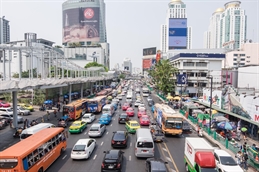
The subject of fine-tuning ways to finance Asia’s seemingly insatiable infrastructure needs were raised during the 5th ASEAN Business Summit in Bangkok. The event was organized by Bloomberg Live.
Asia’s needs are extensive and then some, as Jin Liqun, president of the Asian Infrastructure Investment Bank, lost no time in pointing out. The region needs US$1 trillion over the next 10 years, he said. “It’s a tall order,” he added.
Making that order taller still is the need to get away from the just-get-it-built mentality of the past and buttress need infrastructure with high environmental and governance standards.
Development is hindered by a lack of infrastructure, which does create debt, but once built, hardware allows export industries to develop and debts to subsequently fall as countries become more prosperous, Jin stressed.
There was clear agreement for this from a Southeast Asian country where the spend on infrastructure has been historically smaller and slower and, as a result, its economy has failed to take off in the way others in Southeast Asia have. (The Philippines has spent just 2%-3% annually on infrastructure, much less than the 6%-7%. China spends, for example.)
“We do need to spend more, but we have to spend wisely. I think this is critical,” Vivencio Dizon, president and CEO of the Bases Conversion and Development Authority (BCDA), pointedly said. The BCDA is converting former US and Philippines military bases into civilian- and business-friendly infrastructure.
(This is not a simple repainting job, as two railways are being put in, one connecting the two facilities and another connecting them to Manila, as well as a new terminal at Clark International Airport. See Page 24 for a detailed look at BCDA projects.)
With money already invested and construction underway, the region, north of Manila, is growing faster at 9.3% than the rest of the country is at 6.7%, Dizon said. And, he notes, foreign companies are also moving closer, with Dizon expecting a major American logistics company to move into one of the former bases soon.)
While there are concerns about debts that grandiose (and sometimes misguided) plans incur, one of the changes ongoing in the market is the willingness of governments in the region to use PPPs (public private partnerships) more. This is especially true in Thailand, where once there was a clear aversion to such things.
Thailand’s big push is the Eastern Economic Corridor, where some US$20 billion of projects will be available and will need PPPs, Kanit Sangsubhan, secretary general of the Eastern Economic Corridor Office of Thailand, told the Summit.
What’s more, these are not really donor projects but serious business opportunities for commercial investment, such as private sector banks, and a way of spreading the risk and the debt. “We have been able to do good, bankable projects,” said Sangsubahn.
There is also more forward thinking being done than there was in the past, when the approach was a rather high-handed “once built, they will come.” Now, the thinking, as both Jin of the AIIB and Sangsubhan of the EEC pointed out, is about building and encouraging supporting hardware and software around it.
Here again, recent changes in the PPP market will help. Up until now, the assumption was that PPPs were for the big-ticket pieces of kit: large, multi-billion dollar projects which can be delayed or undermined by lack of supporting infrastructure.
Now, there is an increased willingness to replicate sophisticated structured deals at the smaller end of the market. This, before anyone starts to think about a nice one for their personal portfolio, means projects between US$50 million and US$250 million.
“We need to have more granular projects,” Arv Sreedhar, executive director and head of capital markets for Hong Kong-based asset management company Atlantic Partners Asia, told the Summit.
This makes so much funding more possible and “across the board,” he told Asia Cargo News. “It’s not the big highways, it’s the small ones – and the last mile.”
The task of government is not so much funding as creating the right circumstances in which things can be built by those who will use them, Jin said. “Government should improve the enabling environment, not get involved with the details of the piece.”
One of the problems though, as well as finding the balance between the public and private sectors, is getting the right advice. Myanmar and Laos were held up as countries where needed projects were held up by the lack of good advice.
By Michael Mackey
Southeast Asia Correspondent | Bangkok
Sidebar: Vinfast launches first car at Summit
The 5th ASEAN Business Summit in Bangkok heard how the world is changing with Vinfast, a Vietnamese car manufacturer which used the Summit to announce its first production – and its own twist on logistics.
The Haiphong-based manufacturer, a unit of the diversified Vietnamese Vingroup conglomerate, rolled out its first vehicles in June and will initially concentrate on the domestic market before starting to export them next year, Thuy Le, chair of Vinfast and vice chair Vingroup, said.
Before that happens, the company says it has already found a new way to handle its supply chains, with 10 of its suppliers moving onto a 70 hectare dedicated supplier park next to its own 335 hectare site in Haiphong, which is built on reclaimed land.
“We managed to convince some of them to come and set up there so we can do just-in-time,” Le told the Summit.
– Michael Mackey



